ConvertItSearch (Removal Instructions) - Easy Removal Guide
ConvertItSearch Removal Guide
What is ConvertItSearch?
ConvertItSearch – a browser hijacker that modifies browser preferences to redirect search traffic and show ads
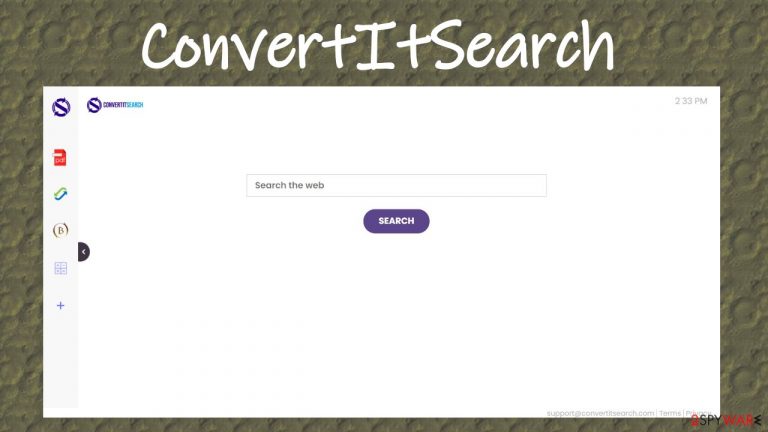
ConvertItSearch is a browser extension or program that displays ads, redirects all search inquiries through a fake search site, and pushes to subscribe to its notifications in order to show even more ads. Due to the alterations of browser settings, including the homepage, new tab, and default search engine, it's deemed as a browser hijacker.
If this browser hijacker infects your device, all your searches will be rerouted through feed.convertitsearch.com. That's an address of a fake search engine as it doesn't generate any results. It shows altered results from, depending on your geolocation, Yahoo, Google, or Bing.
ConvertItSearch ads are displayed as search recommendations, pop-ups, banners, notifications, and alike. They might redirect you to malicious sites, thus making them hazardous. If your device shows any symptoms of infection, please don't click on any of the ads. By reading this article, you'll find out how this infection spreads, its functions, and how to get rid of it once and for all.
| name | ConvertItSearch |
|---|---|
| Type | Push notification virus, browser hijacker, PUP |
| Ip address | 104.31.93.186 |
| promoted search site | feed.convertitsearch.com |
| Altered browser settings | Startpage, new tab, default search engine |
| Distribution | Freeware bundles, deceptive ads, official browser web stores, torrent sites |
| Symptoms | Apart from the changed browser settings, users see more than usual ads, might encounter sudden redirects |
| Risks | Ads and redirects might force into visiting malicious sites. Data collection might lead to privacy issues |
| Removal | Browser hijackers, adware, other PUPs, and malware should be safely eliminated by using a professional anti-malware tool compatible with user devices |
| system fix | To restore system settings and clean up your device, you should use the powerful FortectIntego system repair tool or similar software |
People can infect their computers and cell phones with ConvertItSearch browser hijacker and potentially unwanted programs[1] (PUPs) alike in many ways. A few of the most popular distribution techniques are freeware/software bundles and deceptive ads. For a limited time, they might even be available at official browser web stores.
Modified browser settings that redirect to a fake search site enables ConvertItSearch to collect various non-personal data, including but not limited to:
- search inquiries,
- used apps,
- device and browser details,
- links of visited pages,
- geolocations,
- IP addresses, etc.
Advertisers use this gather information to tailor ads explicitly for you. But if those details fell into the wrong hands, you might become a victim of a cybercrime. Moreover, if ConvertItSearch virus shown ads are clicked, they could redirect to questionable pages that could try to extract private info, force to install additional PUPs or similar shenanigans.
And lastly, if you press the Allow button and subscribe to ConvertItSearch notifications, you might see even more irritating ads. But these ones could start popping up directly on your phone screen or desktop and try to deceive you into pressing them to receive an awesome deal or view an imaginary secret story.
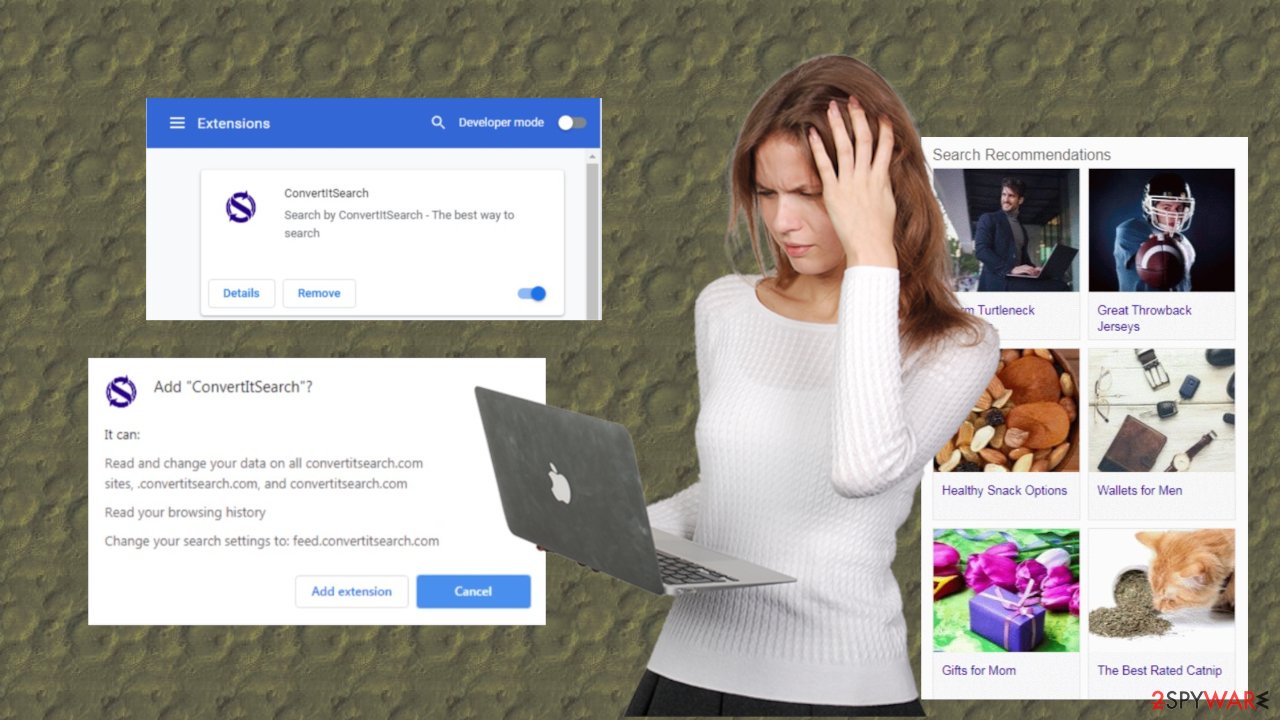
Therefore, it's not wise and unsafe to keep using this browser hijacker. Remove ConvertItSearch by performing a full system scan with a reliable anti-malware tool. If you don't own one, we suggest using trustworthy security tools such as SpyHunter 5Combo Cleaner or Malwarebytes.
When ConvertItSearch removal is completed, and your device is virus-free, you should take care of its overall health. Cybersecurity experts[2] highly recommend using the powerful FortectIntego system repair tool to fix any system-related issues. Furthermore, it will take care of tracking cookies and other browser matters.
Upgrade your software and take other precautionary measures to evade various infections
First, computer viruses were created decades ago,[3] and since then, they have evolved into an enormous illegal business. There are various malware types, from worms to Trojans, and all of them can infect anyone's computer. People have to take cybersecurity seriously as they might become the next victim.
Thus our team has compiled guidelines that would help home users increase their cybersecurity level and minimize the chance of catching an infection. These suggestions don't guarantee that your device won't get infected, but the damages might be a lot lower if you stick to them.
- Keep backups of all essential information on two separate devices. One of them should be offline storage.
- Operating System and other installed software must be up-to-date.
- Professional security tools must be used regularly and their virus databases updated frequently.
- System diagnostic tools or legitimate optimizers should be routinely used to clean up devices and maintain system files and settings in order.
- Read our articles, or google the most popular techniques used by hackers to infect devices to be in the know.
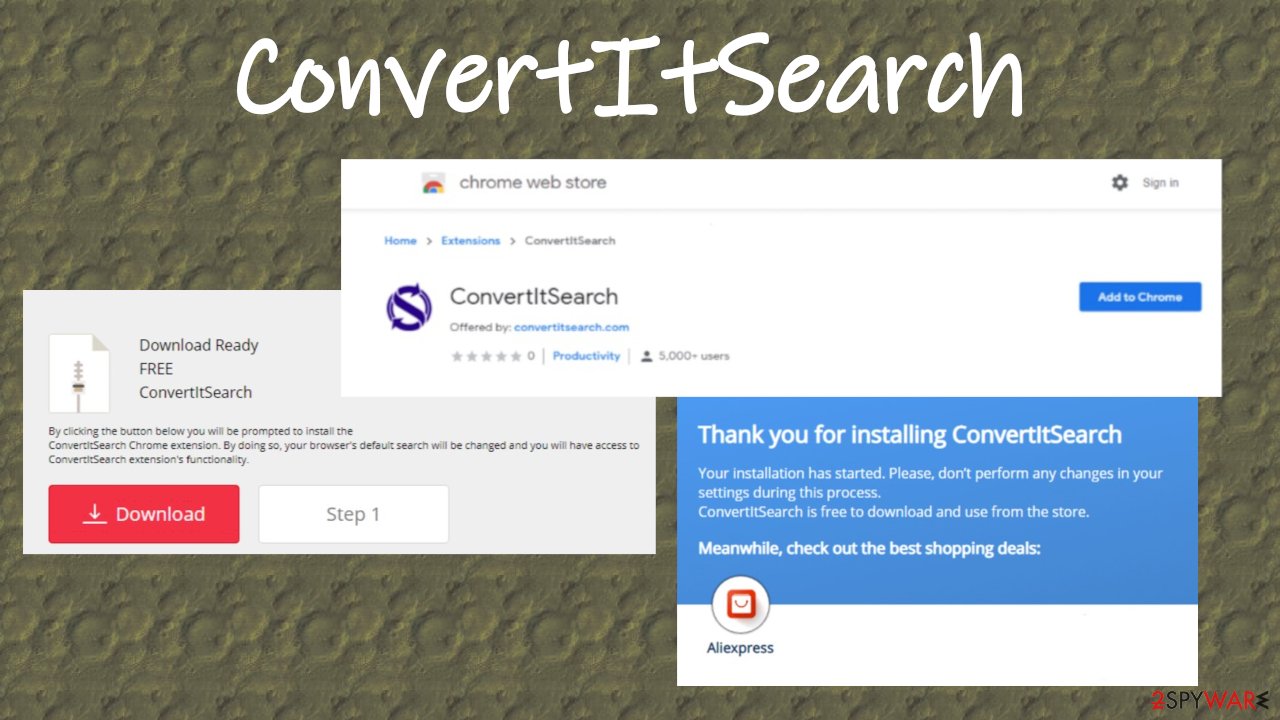
Options for ConvertItSearch virus removal from infected computers and cell phones
Whether you've installed ConvertItSearch willingly or not, clicked on any ads, or allowed its notifications, you have to scan your device for PUPs and malware immediately. Usually, one infection leads to another, so please don't for a minute before eliminating it.
To safely remove ConvertItSearch and any other PUPs, malware, and suspicious files, scan your device with a trustworthy anti-malware tool. When the scan is finished, adhere to the security tools suggestions. Please remember to keep its virus database updated frequently so it could block infections.
In some cases, you might need to finish ConvertItSearch removal manually. That's not that hard and doesn't require extensive IT knowledge. Follow our free tutorials below to eliminate this browser extension from any device and any browser.
You may remove virus damage with a help of FortectIntego. SpyHunter 5Combo Cleaner and Malwarebytes are recommended to detect potentially unwanted programs and viruses with all their files and registry entries that are related to them.
Getting rid of ConvertItSearch. Follow these steps
Uninstall from Windows
Instructions for Windows 10/8 machines:
- Enter Control Panel into Windows search box and hit Enter or click on the search result.
- Under Programs, select Uninstall a program.

- From the list, find the entry of the suspicious program.
- Right-click on the application and select Uninstall.
- If User Account Control shows up, click Yes.
- Wait till uninstallation process is complete and click OK.

If you are Windows 7/XP user, proceed with the following instructions:
- Click on Windows Start > Control Panel located on the right pane (if you are Windows XP user, click on Add/Remove Programs).
- In Control Panel, select Programs > Uninstall a program.

- Pick the unwanted application by clicking on it once.
- At the top, click Uninstall/Change.
- In the confirmation prompt, pick Yes.
- Click OK once the removal process is finished.
Delete from macOS
Remove items from Applications folder:
- From the menu bar, select Go > Applications.
- In the Applications folder, look for all related entries.
- Click on the app and drag it to Trash (or right-click and pick Move to Trash)

To fully remove an unwanted app, you need to access Application Support, LaunchAgents, and LaunchDaemons folders and delete relevant files:
- Select Go > Go to Folder.
- Enter /Library/Application Support and click Go or press Enter.
- In the Application Support folder, look for any dubious entries and then delete them.
- Now enter /Library/LaunchAgents and /Library/LaunchDaemons folders the same way and terminate all the related .plist files.

Remove from Microsoft Edge
Delete unwanted extensions from MS Edge:
- Select Menu (three horizontal dots at the top-right of the browser window) and pick Extensions.
- From the list, pick the extension and click on the Gear icon.
- Click on Uninstall at the bottom.

Clear cookies and other browser data:
- Click on the Menu (three horizontal dots at the top-right of the browser window) and select Privacy & security.
- Under Clear browsing data, pick Choose what to clear.
- Select everything (apart from passwords, although you might want to include Media licenses as well, if applicable) and click on Clear.

Restore new tab and homepage settings:
- Click the menu icon and choose Settings.
- Then find On startup section.
- Click Disable if you found any suspicious domain.
Reset MS Edge if the above steps did not work:
- Press on Ctrl + Shift + Esc to open Task Manager.
- Click on More details arrow at the bottom of the window.
- Select Details tab.
- Now scroll down and locate every entry with Microsoft Edge name in it. Right-click on each of them and select End Task to stop MS Edge from running.

If this solution failed to help you, you need to use an advanced Edge reset method. Note that you need to backup your data before proceeding.
- Find the following folder on your computer: C:\\Users\\%username%\\AppData\\Local\\Packages\\Microsoft.MicrosoftEdge_8wekyb3d8bbwe.
- Press Ctrl + A on your keyboard to select all folders.
- Right-click on them and pick Delete

- Now right-click on the Start button and pick Windows PowerShell (Admin).
- When the new window opens, copy and paste the following command, and then press Enter:
Get-AppXPackage -AllUsers -Name Microsoft.MicrosoftEdge | Foreach {Add-AppxPackage -DisableDevelopmentMode -Register “$($_.InstallLocation)\\AppXManifest.xml” -Verbose

Instructions for Chromium-based Edge
Delete extensions from MS Edge (Chromium):
- Open Edge and click select Settings > Extensions.
- Delete unwanted extensions by clicking Remove.

Clear cache and site data:
- Click on Menu and go to Settings.
- Select Privacy, search and services.
- Under Clear browsing data, pick Choose what to clear.
- Under Time range, pick All time.
- Select Clear now.

Reset Chromium-based MS Edge:
- Click on Menu and select Settings.
- On the left side, pick Reset settings.
- Select Restore settings to their default values.
- Confirm with Reset.

Remove from Mozilla Firefox (FF)
Remove dangerous extensions:
- Open Mozilla Firefox browser and click on the Menu (three horizontal lines at the top-right of the window).
- Select Add-ons.
- In here, select unwanted plugin and click Remove.

Reset the homepage:
- Click three horizontal lines at the top right corner to open the menu.
- Choose Options.
- Under Home options, enter your preferred site that will open every time you newly open the Mozilla Firefox.
Clear cookies and site data:
- Click Menu and pick Settings.
- Go to Privacy & Security section.
- Scroll down to locate Cookies and Site Data.
- Click on Clear Data…
- Select Cookies and Site Data, as well as Cached Web Content and press Clear.

Reset Mozilla Firefox
If clearing the browser as explained above did not help, reset Mozilla Firefox:
- Open Mozilla Firefox browser and click the Menu.
- Go to Help and then choose Troubleshooting Information.

- Under Give Firefox a tune up section, click on Refresh Firefox…
- Once the pop-up shows up, confirm the action by pressing on Refresh Firefox.

Remove from Google Chrome
Delete malicious extensions from Google Chrome:
- Open Google Chrome, click on the Menu (three vertical dots at the top-right corner) and select More tools > Extensions.
- In the newly opened window, you will see all the installed extensions. Uninstall all the suspicious plugins that might be related to the unwanted program by clicking Remove.

Clear cache and web data from Chrome:
- Click on Menu and pick Settings.
- Under Privacy and security, select Clear browsing data.
- Select Browsing history, Cookies and other site data, as well as Cached images and files.
- Click Clear data.

Change your homepage:
- Click menu and choose Settings.
- Look for a suspicious site in the On startup section.
- Click on Open a specific or set of pages and click on three dots to find the Remove option.
Reset Google Chrome:
If the previous methods did not help you, reset Google Chrome to eliminate all the unwanted components:
- Click on Menu and select Settings.
- In the Settings, scroll down and click Advanced.
- Scroll down and locate Reset and clean up section.
- Now click Restore settings to their original defaults.
- Confirm with Reset settings.

Delete from Safari
Remove unwanted extensions from Safari:
- Click Safari > Preferences…
- In the new window, pick Extensions.
- Select the unwanted extension and select Uninstall.

Clear cookies and other website data from Safari:
- Click Safari > Clear History…
- From the drop-down menu under Clear, pick all history.
- Confirm with Clear History.

Reset Safari if the above-mentioned steps did not help you:
- Click Safari > Preferences…
- Go to Advanced tab.
- Tick the Show Develop menu in menu bar.
- From the menu bar, click Develop, and then select Empty Caches.

Uninstall from Android
Uninstall unwanted programs from Android device:
- Go to Settings -> Apps/Applications.
- Expand the full list of the installed apps.
- Scroll through the list and tap on a suspicious application once.
- Tap on it and select Uninstall.
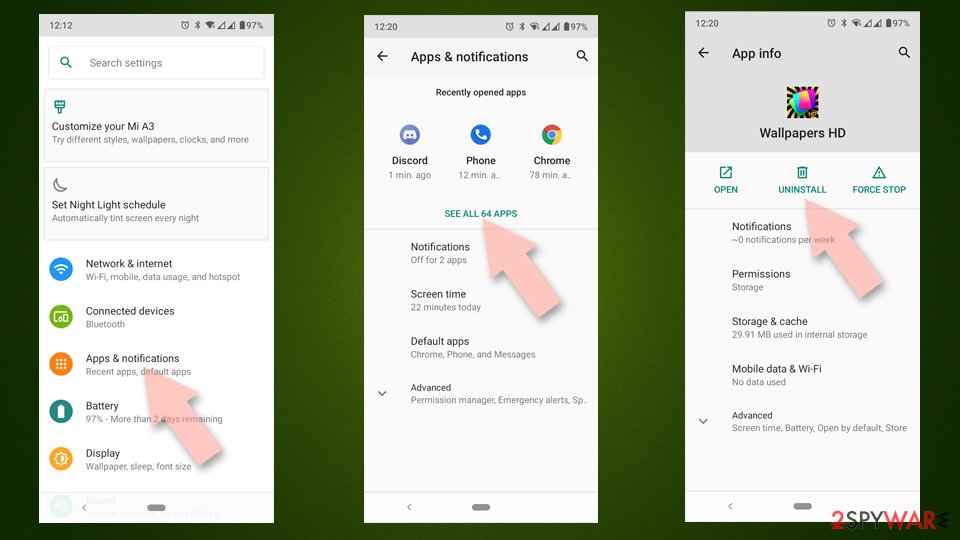
- Reboot the device.
Clear Storage and data files on Android from Google Chrome or other apps:
- Go to Settings > Apps/Applications.
- Expand the full list of the installed apps.
- Tap on Chrome and select Storage & cache.
- Clear storage and clear cache of the app.
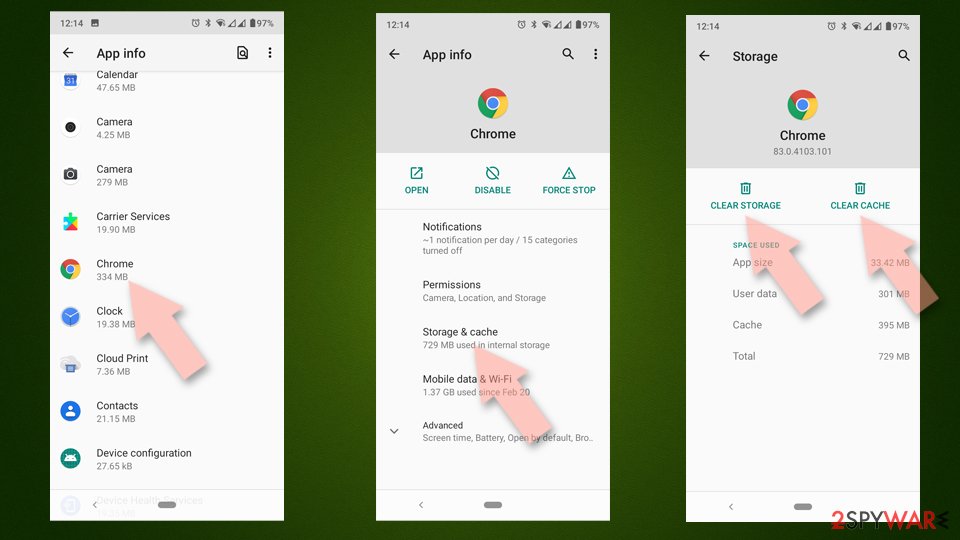
If you are seeing ads on top of other apps but are not sure what is causing it, perform the following steps:
- Go to Apps/Applications.
- Tap Advanced.
- Select Special App access.
- Tap on Display over other apps.
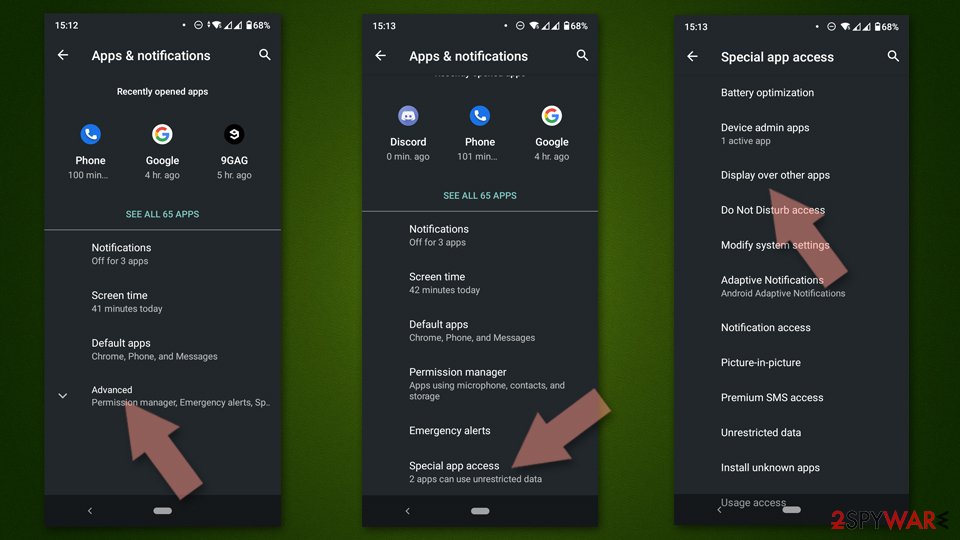
- Eliminate apps with these access rights enabled.
Stop browser notifications
Remove unwanted notifications from Google Chrome (desktop):
- Open Google Chrome browser and go to Menu > Settings.
- Scroll down and click on Advanced.
- Locate Privacy and security section and pick Site Settings > Notifications.

- Look at the Allow section and look for a suspicious URL.
- Click the three vertical dots next to it and pick Block. This should remove unwanted notifications from Google Chrome.

Remove unwanted notifications from Google Chrome (Android):
- Open Google Chrome and tap on Settings (three vertical dots).
- Select Notifications.
- Scroll down to the Sites section.
- Locate the unwanted URL and toggle the button to the left (Off setting).

Remove unwanted notifications from Mozilla Firefox:
- Open Mozilla Firefox and go to Menu > Options.
- Click on Privacy & Security section.
- Under Permissions, you should be able to see Notifications. Click the Settings button next to it.

- In the Settings – Notification Permissions window, click on the drop-down menu by the URL in question.
- Select Block and then click on Save Changes. This should remove unwanted notifications from Mozilla Firefox.

Remove unwanted notifications from Safari:
- Click on Safari > Preferences…
- Go to the Websites tab and, under General, select Notifications.
- Select the web address in question, click the drop-down menu and select Deny.

Remove unwanted notifications from MS Edge:
- Open Microsoft Edge, and click the Settings and more button (three horizontal dots) at the top-right of the window.
- Select Settings and then go to Advanced.
- Under Website permissions, pick Manage permissions and select the URL in question.

- Toggle the switch to the left to turn notifications off on Microsoft Edge.

Remove unwanted notifications from MS Edge (Chromium):
- Open Microsoft Edge, and go to Settings.
- Select Site permissions.
- Go to Notifications on the right.
- Under Allow, you will find the unwanted entry.
- Click on More actions and select Block.

Remove unwanted notifications from Internet Explorer:
- Open Internet Explorer, and click on the Gear icon at the top-right of the window.
- Select Internet options and go to the Privacy tab.
- In the Pop-up Blocker section, click on Settings.
- Locate web address in question under Allowed sites and pick Remove.

After uninstalling this potentially unwanted program (PUP) and fixing each of your web browsers, we recommend you to scan your PC system with a reputable anti-spyware. This will help you to get rid of ConvertItSearch registry traces and will also identify related parasites or possible malware infections on your computer. For that you can use our top-rated malware remover: FortectIntego, SpyHunter 5Combo Cleaner or Malwarebytes.
How to prevent from getting browser plugins
Access your website securely from any location
When you work on the domain, site, blog, or different project that requires constant management, content creation, or coding, you may need to connect to the server and content management service more often. The best solution for creating a tighter network could be a dedicated/fixed IP address.
If you make your IP address static and set to your device, you can connect to the CMS from any location and do not create any additional issues for the server or network manager that needs to monitor connections and activities. VPN software providers like Private Internet Access can help you with such settings and offer the option to control the online reputation and manage projects easily from any part of the world.
Recover files after data-affecting malware attacks
While much of the data can be accidentally deleted due to various reasons, malware is one of the main culprits that can cause loss of pictures, documents, videos, and other important files. More serious malware infections lead to significant data loss when your documents, system files, and images get encrypted. In particular, ransomware is is a type of malware that focuses on such functions, so your files become useless without an ability to access them.
Even though there is little to no possibility to recover after file-locking threats, some applications have features for data recovery in the system. In some cases, Data Recovery Pro can also help to recover at least some portion of your data after data-locking virus infection or general cyber infection.
- ^ Potentially unwanted program. Wikipedia. The free encyclopedia.
- ^ Senzavirus. Senzavirus. Spyware news and security.
- ^ Danny Palmer. What is malware? Everything you need to know about viruses, trojans and malicious software. Zdnet. Technology news, analysis and comments.
